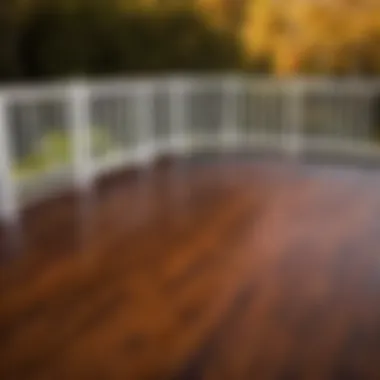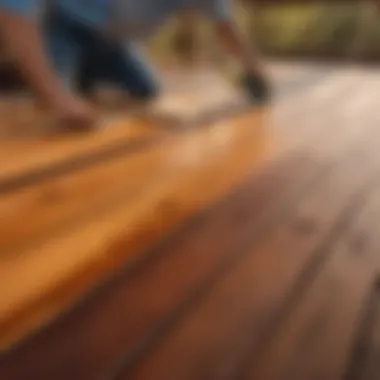Materials:
To refinish your deck, you will need the following materials:
- Deck cleaner: 1 gallon
- Deck stain: 2 gallons
- Sandpaper: medium and fine grit
- Paintbrushes: various sizes
- Painter's tape
- Plastic sheeting
- Protective gear: mask, gloves, goggles
- Wood filler
- Putty knife
Procedure:
Step 1: Preparation
- Clear the deck of all furniture and plants.
- Sweep and scrub the surface with deck cleaner to remove dirt and grime.
- Sand any rough areas with medium-grit sandpaper.
- Replace any damaged boards and fill in cracks with wood filler.
Step 2: Staining
- Tape off areas you don't want to stain.
- Stir the deck stain thoroughly before applying with a large brush.
- Work in small sections to ensure even coverage.
Step 3: Finishing Touches
- Allow the stain to dry completely between coats.
- Apply a second coat if needed for a deeper color.
- Remove tape and plastic sheeting once the final coat is dry.
Technical Considerations:


For optimal results, ensure you have the following tools and follow these timing specifics:
- Tools: Paintbrush, roller, ladder
- Timing: Plan to refinish your deck during a dry period to allow for proper drying times.
Troubleshooting Tips:


If you encounter issues during the refinishing process, consider these solutions:
- Uneven stain application: Sand down the area and reapply the stain.
- Peeling or flaking: Strip the affected area and start the staining process again.
- Color mismatch: Use a wood tint to adjust the shade.
From start to finish, following these meticulous instructions and utilizing the right tools will result in a beautifully refinished deck that you can enjoy for years to come!
Introduction


In the realm of home improvement projects, refinishing a deck stands out as a significant undertaking that offers a multitude of benefits and is quintessential for maintaining the longevity and aesthetic appeal of your outdoor living space. This article serves as the ultimate companion, guiding you through every intricate detail and essential step required to revamp your deck into a stunning oasis of relaxation and entertainment. As a housewife or homeowner, it is vital to grasp the significance of proper deck maintenance and refinishing to ensure the structural integrity, visual allure, and value enhancement of your property.
To embark on the journey of refinishing a deck is to embark on a transformative process that not only rejuvenates the surface but also safeguards it against the relentless elements of nature, such as harsh sunlight, rain, and temperature fluctuations. By delving into the nitty-gritty of deck refinishing, you equip yourself with the knowledge and expertise needed to preserve the beauty and functionality of your deck for years to come. This comprehensive guide epitomizes the ideal resource for embarking on the rewarding endeavor of refurbishing your deck, encapsulating all the crucial nuances and techniques required to achieve impeccable results.
By understanding the specific elements of deck refinishing covered in this guide, including assessment, preparation, repair, restoration, refinishing techniques, and finishing touches, you equip yourself with a holistic perspective on the intricacies of deck refurbishment. From meticulous inspections to selecting the perfect stain color, each element plays a vital role in elevating your deck to its pristine potential while ensuring structural integrity and visual appeal.
In this high-IQ discourse, we transcend the mundane directives often found in typical guides and delve deeply into the art and science of refinishing a deck. Our aim is not only to inform but to enlighten and empower you with the requisite knowledge to undertake this transformative project with confidence and proficiency. As we navigate through each section of this article, from the initial assessment to the final embellishments, prepare to immerse yourself in a wealth of detailed guidance that will elevate your deck refurbishing experience to new heights.
Assessment and Preparation
When it comes to refinishing your deck, the Assessment and Preparation stage is crucial for ensuring a successful restoration process. This section focuses on laying the groundwork for the rest of the refinishing project by assessing the condition of the deck and preparing it for the subsequent steps.
Inspecting the Deck
Before diving into the refinishing process, inspecting the deck is paramount. This step involves a detailed examination to identify any areas that require repair or restoration. Checking for damage and spotting signs of rot or decay are key aspects of this inspection.
Check for Damage
Inspecting the deck for any signs of damage such as cracks, splinters, or structural issues is essential. By identifying and addressing these damages early on, you can prevent further deterioration and ensure the longevity of your deck. Regularly checking for damage is a proactive approach that helps maintain the structural integrity of your deck.
Identify Rot or Decay
Rot and decay can compromise the stability and safety of your deck. Identifying areas affected by rot or decay is crucial in preventing safety hazards and structural damage. By addressing rot or decay promptly, you can preserve the lifespan of your deck and maintain its aesthetics.
Cleaning the Deck Surface
Once the inspection is complete, the next step in the Assessment and Preparation phase is cleaning the deck surface. This involves removing debris, dirt, and old finishes to create a clean and smooth surface for refinishing.
Sweeping and Clearing Debris
Removing debris such as leaves, twigs, and other buildup is necessary to prevent mold and mildew growth. Sweeping and clearing debris not only improves the appearance of your deck but also prepares it for further restoration steps. This initial cleaning sets the foundation for a thorough refinishing process.
Pressure Washing
For a deeper clean, pressure washing is an effective method to blast away ingrained dirt and grime. Pressure washing helps revive the wood's natural color and prepare it for staining or painting. However, caution must be taken to avoid damaging the wood surface with excessive pressure.
Stripping Old Finish
After the deck surface is clean, stripping the old finish is essential for achieving a smooth and even application of the new stain or paint. Choosing the right stripper and implementing proper application techniques are critical in this stage.
Choosing the Right Stripper
Selecting a high-quality and suitable deck stripper ensures efficient removal of old finishes without damaging the wood. Consider factors such as the type of wood and the previous finish to choose a compatible stripper. Investing in a premium product enhances the stripping process and leads to better results.
Application Techniques
Applying the stripper correctly is key to achieving optimal results. Whether using a brush, roller, or sprayer, the application technique influences the efficiency of the stripping process. Understanding the instructions provided by the manufacturer and following best practices guarantee a successful stripping outcome.
Repair and Restoration
Repair and restoration play a crucial role in the comprehensive process of refinishing a deck. Ensuring that the deck is structurally sound is paramount to its longevity and aesthetic appeal. This section focuses on key elements such as replacing damaged boards, fixing loose nails and screws, and addressing any underlying structural issues.
Replacing Damaged Boards
When it comes to the aspect of board selection, choosing the right material is vital for the overall integrity of the deck. Opting for high-quality, rot-resistant wood like cedar or pressure-treated lumber can significantly prolong the life of the deck. These materials offer durability and weather resistance, making them ideal choices for deck restoration projects. Additionally, the selection of boards should align with the existing deck style and color scheme to ensure a seamless finish.
In terms of the installation process, attention to detail is key. Properly aligning the boards, using the correct fasteners, and ensuring adequate spacing are essential steps to guarantee a sturdy and visually appealing result. Following manufacturer guidelines for installation and considering factors such as climate and usage patterns are important considerations during this phase of deck repair.
Fixing Loose Nails and Screws
Identifying loose fasteners is a crucial step in maintaining deck safety and stability. Loose nails and screws create potential hazards and compromise the structural integrity of the deck. Regular inspections and timely repairs can prevent further damage and ensure a safe outdoor space for homeowners and their families.
When it comes to reattaching securely, using the appropriate fasteners and techniques is key. Replacing old or damaged fasteners with corrosion-resistant options can prevent future issues and extend the lifespan of the deck. Securely attaching loose nails and screws not only enhances the deck's strength but also enhances its overall appearance.
Addressing Structural Issues
Conducting a thorough support beam inspection is essential for identifying any underlying structural issues that may compromise the deck's safety. Signs of rot, insect damage, or warping should be addressed promptly to prevent further deterioration. Reinforcing or replacing damaged support beams can restore the deck's stability and prevent potential hazards.
Addressing stability concerns involves assessing the overall structural integrity of the deck. Implementing bracing or additional supports in areas prone to movement or stress can enhance the deck's stability and safety. Regular maintenance and inspections are vital for ensuring the long-term stability and safety of the deck for homeowners and their guests.
Refinishing Techniques
When it comes to refinishing a deck, the techniques utilized play a crucial role in the overall success of the project. The choice of refinishing techniques significantly impacts the durability, appearance, and longevity of the deck's finish. By understanding and implementing the right techniques, homeowners can ensure that their deck not only looks beautiful but also stands the test of time. In this section, we will explore key refinishing techniques that are essential for achieving a professional finish that breathes new life into the deck.
Choosing the Right Stain or Paint
Selecting the appropriate stain or paint for refinishing the deck is a pivotal decision in the process. When it comes to Considerations for Wood Type, understanding the characteristics of different wood types is imperative. Factors such as wood species, porosity, and natural color influence the type of stain that will provide the best results. By matching the stain to the wood type, homeowners can enhance the natural beauty of the deck while ensuring protection against elements like UV rays and moisture.
In terms of Color Selection, homeowners need to consider both aesthetic preferences and functional aspects. The color of the stain or paint can impact the overall ambiance of the outdoor space, so choosing a hue that complements the house's exterior and landscape is vital. Additionally, selecting a shade that offers UV protection or heat reflectivity can help maintain the deck's condition over time.
Application Methods
The application method chosen for refinishing the deck can significantly influence the final outcome. When weighing Brushing vs. Rolling, homeowners should consider factors such as finish quality, efficiency, and personal comfort with the application technique. Brushing allows for more control and precision in hard-to-reach areas, while rolling may offer quicker coverage for larger surface areas.
On the other hand, Sprayer Application provides a versatile and time-efficient method for applying stain or paint to the deck. Sprayers ensure an even coat of finish, especially on larger decks, leading to a more consistent appearance. However, maintaining an appropriate distance and consistent speed while spraying is essential to avoid over-application or streaking.
Drying and Curing
After applying the stain or paint, allowing sufficient time for drying and curing is essential to ensure a flawless finish. Optimal Conditions for drying include factors like temperature, humidity, and ventilation. Choosing a dry and temperate day for refinishing will promote faster drying times and optimal absorption of the finish into the wood.
Ensuring Proper Set Time is crucial to prevent premature wear or damage to the newly applied finish. Setting time recommendations vary depending on the type of stain or paint used, as well as environmental conditions. Following manufacturer guidelines and allowing ample time for the finish to cure properly will enhance the deck's longevity and resistance to wear and tear.
Finishing Touches
In the realm of deck refinishing, the section on Finishing Touches often plays a pivotal role in elevating the overall aesthetic and durability of your deck. This crucial stage goes beyond just adding visual appeal; it encompasses crucial aspects that enhance protection and longevity. Deck sealing and protecting not only enriches the visual allure of your deck but also shields it against environmental stressors like UV rays, moisture, and foot traffic. Through sealing, you establish a barrier that prevents water penetration, inhibits mold and mildew growth, and reduces the risk of cracking or warping in the wood. The Benefits of Sealing are immense; it prolongs the lifespan of your deck, maintains its color vibrancy, and promotes a low-maintenance regime. By applying a protective sealant, you not only enhance the natural beauty of the wood but also create a robust shield against wear and tear, ensuring your deck withstands the test of time with grace.
Sealing and Protecting
Benefits of Sealing
Sealing your deck presents a multitude of advantages that bolster the overall durability and appearance. One key aspect of Benefits of Sealing is its ability to act as a preventive measure against common deteriorating factors. Sealants create a waterproof barrier that safeguards the wood from moisture infiltration, minimizing the risk of rot or decay. The longevity of your deck is significantly extended as sealing protects it from UV rays, preventing color fading and surface degradation. Furthermore, sealed decks require less frequent maintenance, reducing the time and effort needed for upkeep. Although the initial application may require a bit of effort, the long-term benefits of Sealing far outweigh the investment, making it a popular choice among homeowners seeking a resilient and aesthetically pleasing deck.
Applying a Protective Sealant
Applying a Protective Sealant is a meticulous process that demands attention to detail for optimal results. The key characteristic of a quality sealant lies in its ability to penetrate deep into the wood, forming a strong bond that withstands external elements. Choosing a sealant with UV protection properties ensures that your deck remains vibrant and protected against sun exposure. Additionally, a protective sealant acts as a shield against water damage, preventing moisture-related issues such as rot and mold. While the application process requires proper preparation and technique, the advantages of a Protective Sealant are undeniable in safeguarding your deck against wear and tear, enhancing its lifespan, and preserving its visual appeal.
Enhancing with Accessories
Deck Railing Options
When considering Deck Railing Options, it's essential to weigh both practicality and aesthetics to enhance the visual appeal and safety of your deck. A key characteristic of deck railings is their ability to provide support and safety to the space, especially in elevated or high-traffic areas. Opting for materials such as wood, metal, glass, or composite offers a wide range of design choices to complement your deck's style. Deck railings not only provide a secure boundary but also add a decorative element that can significantly elevate the overall look of your outdoor space. Despite the initial investment, deck railings offer long-term benefits in terms of safety, style, and value, making them a popular choice among homeowners aiming to enhance their deck's functionality and appeal.
Lighting Ideas
Lighting Ideas play a crucial role in transforming your deck into a welcoming and functional space, especially during evening hours. The key characteristic of deck lighting is its ability to extend the functionality of your outdoor area, creating a warm ambiance and enhancing visibility for evening gatherings or relaxation. Selecting lighting fixtures that balance practicality and aesthetics can accentuate architectural features, highlight landscaping elements, and provide a cozy atmosphere. From versatile LED lights to elegant sconces and string lights, the options are plentiful to complement your deck's design and cater to your lighting needs. While lighting installation may require some upfront investment, the benefits of a well-lit deck in terms of safety, aesthetics, and usability are invaluable, enriching your outdoor experience and extending your deck's functionality beyond daylight hours.
Regular Maintenance Tips
Cleaning Schedule
Establishing a consistent Cleaning Schedule is fundamental in preserving the cleanliness, appearance, and durability of your deck. The key characteristic of a regular cleaning routine is its ability to prevent dirt, debris, and mold buildup that can impact the integrity of the wood. Routine cleaning not only maintains the visual appeal of your deck but also prevents slippery surfaces and potential safety hazards. By adhering to a structured cleaning schedule that includes sweeping, scrubbing, and appropriate cleaning solutions, you can prolong the lifespan of your deck and ensure it retains its pristine condition for years to come. While cleaning may seem like a mundane task, the benefits of a well-maintained deck in terms of longevity, safety, and aesthetics make it a necessary step in your deck care routine.
Seasonal Inspections
Conducting Seasonal Inspections is crucial for identifying potential issues early on and addressing them before they escalate. The key characteristic of seasonal inspections lies in their proactive approach to detecting any signs of wear, damage, or structural issues that may compromise the integrity of your deck. From checking for loose boards and fasteners to inspecting the overall stability and support structure, seasonal inspections ensure that your deck remains safe, functional, and visually appealing throughout the year. Investing time in regular evaluations and maintenance not only prolongs the lifespan of your deck but also minimizes the risk of costly repairs or replacements in the future. The advantages of proactive seasonal inspections are significant in maintaining a safe, structurally sound, and aesthetically pleasing deck that you can enjoy with peace of mind.





